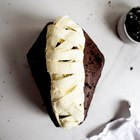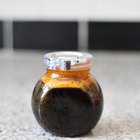Caramel is a familiar flavoring found around the world, but there is no such thing as a caramel plant or caramel extract–caramel has to be created. But from what? Caramel is the (scientific) outcome of heated sugar molecules mixed with a dairy product. White sugar and white cream make for brown caramel as a result of the Maillard reaction between the milk proteins and the fast-moving sugar molecules. Therefore, the key to making a hard candy is reaching the right temperature; "almost the right temperature" is not an option. The exact degree must be reached or a caramel syrup similar to dulce de leche will be produced.
Bring to boil 1 cup cream, 1 ½ cups corn syrup, 2 cups sugar, and 1 cup (two sticks) butter in a heavy saucepan. Stir the entire entire time until boil is reached.
Add the remaining cup of cream and stop stirring (let the candy bubble on its own, even if it looks a bit foreboding). Let it remain untouched until the candy thermometer reads 250 degrees F. If you do not let it reach this temperature, it will not harden. A thermometer is not optional, as blind guessing may produce unknown results, or it may burn. Test a piece of the candy in a glass of cold water: if it forms a hard ball then it is ready.
Spray or grease a 9 by 13 glass baking dish. Do not line with wax paper or it will melt and fuse to the candy. Before pouring the hot candy mixture into the pan, stir in vanilla extract (or other alcohol-based addition). Place the dish in the refrigerator and leave until completely cool.
Invert from pan onto a cutting board when cool, and using a strong heavy knife or spade, cut into pieces. If it is brittle enough, use your hands to break into uneven pieces reminiscent of a candy bark.
Wrap the caramels in small squares of wax paper and twist the ends. If in broken shard form, fill a candy tin or gift box lined with tissue papers.
Reheat caramel if the first heating did not produce the desired hardness. Put it back into the pot and heat again to a higher temperature (or try the microwave). The result should be much harder in texture.
Related Articles

How to Make Chocolate Ganache With ...

How to Make Peppermint Candy

No-Tweeze Hair Remover Instructions

Substitute for Heavy Whipping Cream in ...

How to Make Whipped Frosting Without ...

How to Make a Mummy on a Coffin Cake

How to Make Hard Crack Candy

How to Make Beeswax Face Cream

What Is "Cultured Cream"?

The History of Caramel Candy

How to Melt Shortening

How to Make Maple Cream in a Stand Mixer

How to Fix Grainy Whipped Ganache

Baking Pudding With Brownies

How to Harden Up Whipped Cream

How to Seal Jelly With Wax

What Are Sugar Crystals?

The Difference Between Butter Cream and ...

How to Make Aloe & Seaweed Lotion

How to Make Arabic Wax for Hair Removal
References
Tips
- Alternative ingredients: following the same method, replace half cup of cream and half cup of sugar with one can sweetened condensed milk. Do not attempt to make these if you are in a climate of high humidity or they will be sticky and somewhat soft.
Writer Bio
Mallory Ferland has been writing professionally since her start in 2009 as an editorial assistant for Idaho-based Premier Publishing. Her writing and photography have appeared in "Idaho Cuisine" magazine, "Spokane Sizzle" and various online publications. She graduated from Gonzaga University in 2009 with Bachelor of Arts degrees in history and French language and now writes, photographs and teaches English in Sao Paulo, Brazil.